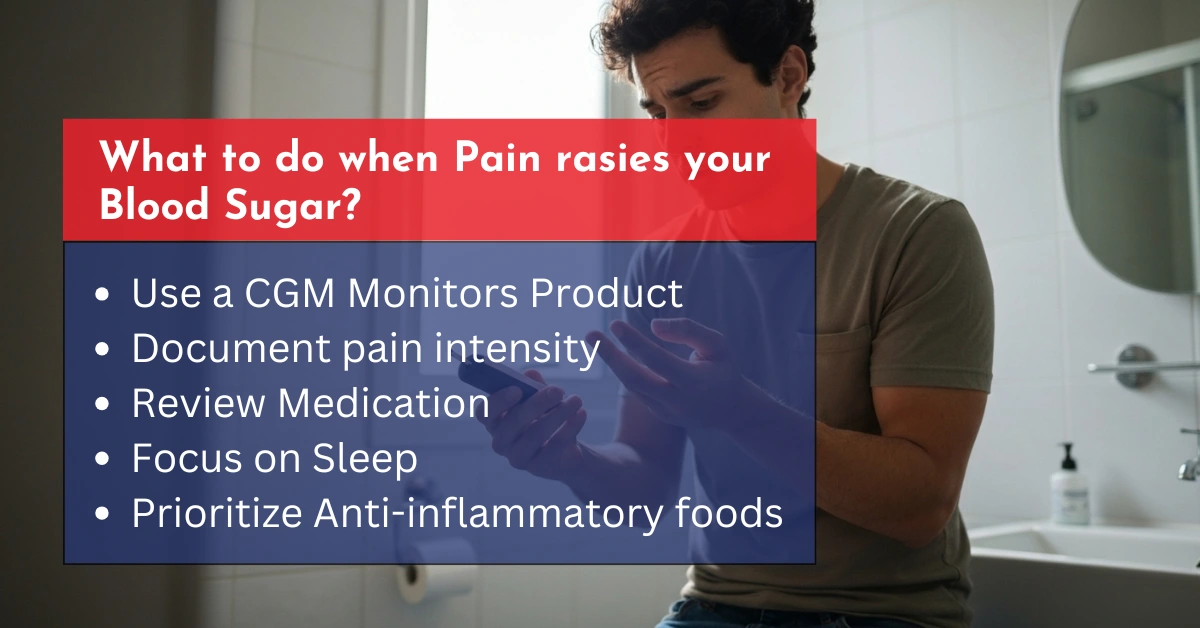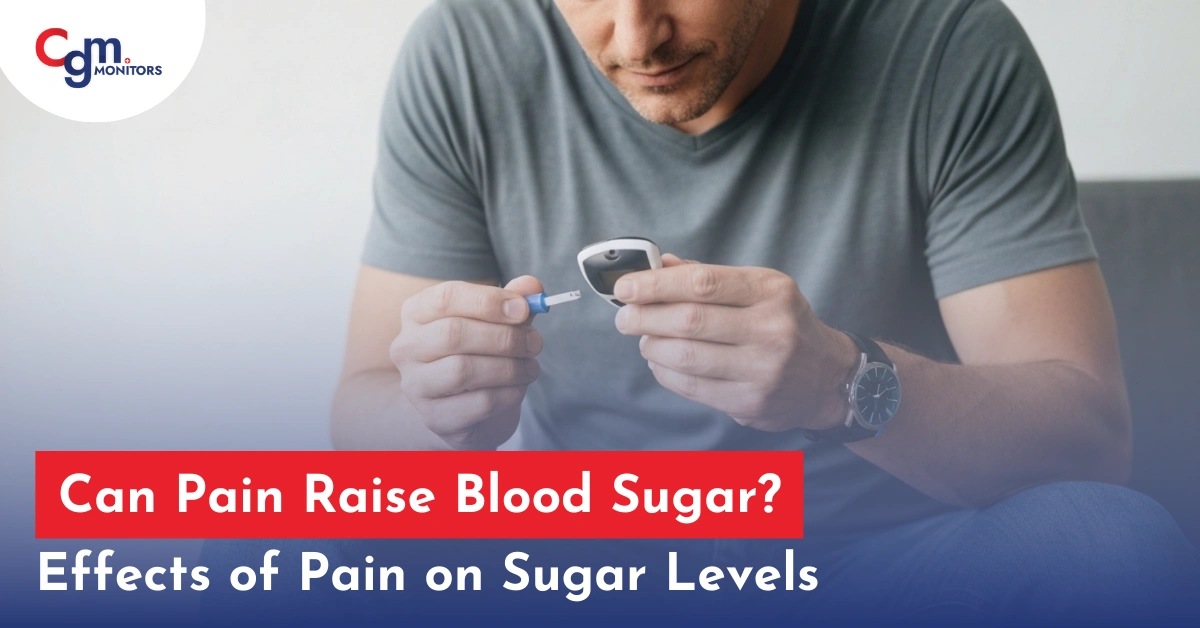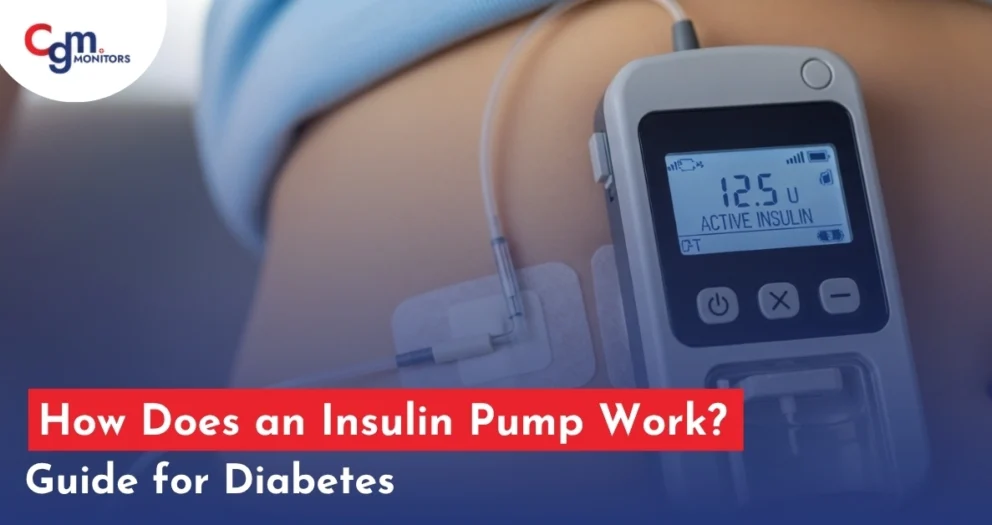Table of content
- The Biology Behind Pain-Induced Glucose Elevation:
- Hormonal Response to Pain and Glucose Impact
- Can Being in Pain Raise Your Blood Sugar Daily?
- Acute vs. Chronic Pain: Different Glucose Patterns
- Blood Sugar Patterns Based on Pain Type
- Can Chronic Pain Raise Blood Sugar Over Weeks or Months?
- Can Pain Meds Raise Blood Sugar?
- Can Back Pain Raise Blood Sugar?
- Can Severe Pain Raise Blood Sugar More Than Mild Pain?
- Can Stress and Pain Raise Blood Sugar Together?
- How CGM Monitors Help Track Pain-Related Glucose Spikes
- What to Do When Pain Raises Your Blood Sugar
- Conclusion: Pain and Blood Sugar
Can Pain Raise Blood Sugar? Indeed, the body’s response is something that can be measured and is of medical importance. Pain engages the body’s stress response system, which releases certain hormones that increase blood sugar levels even in the absence of food. This poses a problem for patients with diabetes, prediabetes, or those with metabolic syndrome: unexplained hyperglycemia during or following painful episodes.
Whether triggered by chronic pain, back pain, post-operative discomfort, or the use of certain analgesics, patients often experience elevated glucose levels—detected through Continuous Glucose Monitoring (CGM)—that are unrelated to food intake. Knowing this relationship helps in avoiding unwanted medication changes and provides better management of glucose control in real-time with CGM systems available at CGM Monitors.
The Biology Behind Pain-Induced Glucose Elevation:
While pain is discomforting to experience, it also activates the stress response of the body, which triggers the hypothalamic-pituitary-adrenal (HPA) axis, resulting in a cascade of hormonal changes. Some of these hormones are cortisol, epinephrine, and norepinephrine, which directly affect glucose metabolism.
Important Factors That Increase Glucose Levels During Pain:
- Cortisol: Causes greater insulin resistance and stimulates the release of glucose from the liver
- Epinephrine: Increases blood glucose concentration by inducing glycogenolysis
- Norepinephrine: Increases the vasoconstrictor effect on blood vessels and lowers insulin sensitivity
- Inflammatory cytokines (e.g., IL-6, TNF-α): Disrupt insulin pathways and β-cell function
This is why pain and stress raise blood sugar both directly (via hormones) and indirectly (via inflammation and poor insulin utilisation).
Hormonal Response to Pain and Glucose Impact
| Hormone | Triggered by | Effect on Blood Sugar |
| Cortisol | Acute & Chronic Pain | High Gluconeogenesis, low Insulin Resistance |
| Epinephrine | Sudden Pain/Stress | High Glycogen Breakdown, low Insulin Secretion |
| Norepinephrine | Pain + Stress | High Blood Pressure, low Glucose Tolerance |
| IL-6, TNF-α | Inflammatory Pain | Low Insulin Sensitivity, β-cell Dysfunction |
Can Being in Pain Raise Your Blood Sugar Daily?
Absolutely! Persistent pain—from arthritis, fibromyalgia, or neuropathy—leads to ongoing cortisol elevation. CGM users often see daily blood sugar increases unrelated to food. These spikes are hormonally driven, not dietary.
This means you can experience high glucose even with a low-carb meal plan or physical activity. Many patients with chronic pain develop what’s known as pain-induced insulin resistance, making management harder without tools like CGM.
Acute vs. Chronic Pain: Different Glucose Patterns
The duration and intensity of pain affect how blood glucose behaves. CGM data shows distinct trends in acute vs. chronic pain states.
Blood Sugar Patterns Based on Pain Type
| Pain Type | Duration | Glucose Pattern Seen in CGM |
| Acute Pain | Minutes to Hours | Sudden glucose spike, resolves as pain subsides |
| Chronic Pain | Weeks to Years | Persistent mild elevations, higher morning fasting levels |
| Severe Pain | Ongoing, Intense | Sustained elevations, often 20–40 mg/dL above baseline |
Can Chronic Pain Raise Blood Sugar Over Weeks or Months?
Yes. Can chronic pain raise blood sugar long-term? Absolutely. Chronic pain contributes to sustained hormonal stress, which worsens insulin sensitivity over time. This elevates fasting glucose levels, particularly in the morning (also known as the dawn phenomenon). Pain conditions strongly linked with chronic hyperglycemia include:
- Sciatica
- Diabetic neuropathy
- Osteoarthritis
- Post-surgical pain
- Rheumatoid arthritis
Patients often need therapy adjustments during periods of high pain to stabilize glucose.
Can Pain Meds Raise Blood Sugar?
Yes, and significantly. Certain medications prescribed to manage pain can elevate blood glucose levels both directly and indirectly. With that in mind, here’s some key information:
• Corticosteroids (Prednisone, methylprednisolone):
These drugs literally and figuratively ‘bring sugar’ as they raise blood sugar levels by increasing glucose production in the liver and worsening insulin resistance.
• Opioids (Morphine, Oxycodone):
May blunt insulin secretion and cause erratic appetite leading to worsening blood sugar levels.
• NSAIDs (Naproxen, Ibuprofen):
While mostly safe as far as glucose control is concerned, their use could lead to chronic kidney disease which is known to worsen diabetes control.
• Neuropathic Pain Agents (Gabapentin, Pregabalin):
Associated with weight gain and glucose imbalance with prolonged use.
• Neuropathic pain agents (e.g., gabapentin, pregabalin):
Associated with weight gain and glucose imbalance during extended use.
In short, can pain meds raise blood sugar? Yes. And some pain medication raises blood sugar levels enough to warrant ongoing CGM tracking and dosage adjustment.
Can Back Pain Raise Blood Sugar?
Yes. Back pain is associated with inflammation, reduced mobility, and disrupted sleep—all of which contribute to hyperglycemia. Those with lumbar disc disease or muscle spasms often report elevated fasting blood glucose, especially on CGM. Even non-diabetic patients may experience glucose intolerance when back pain becomes chronic.
Can Severe Pain Raise Blood Sugar More Than Mild Pain?
Yes. The intensity of pain determines the magnitude of the glucose response. Severe pain raises blood sugar more dramatically due to:
- Stronger cortisol release
- Greater suppression of insulin secretion
- More significant sympathetic nervous system activation
- Emotional and physical distress
This is most evident in postoperative patients, those with trauma, or during labour. CGM data often shows blood sugar rising 20–40 mg/dL above baseline during episodes of intense pain.
Can Stress and Pain Raise Blood Sugar Together?
Yes—and the combination creates additive effects. For example, someone with chronic pain and anxiety will often experience greater glycemic variability, especially in the late afternoon or evening. The hormonal synergy between cortisol and adrenaline results in unpredictable glucose swings that only real-time tracking can detect.
CGM is particularly useful here, helping:
- Identify pain + stress triggers
- Adjust medication timing
- Improve treatment personalisation
This is where CGM Monitors, like the Dexcom G7, offer a measurable advantage—providing real-time glucose data to support personalized, informed decisions.
How CGM Monitors Help Track Pain-Related Glucose Spikes
Traditional glucose meters only offer single-point readings. In contrast, CGM monitors track your glucose patterns 24/7, showing how pain, stress, or medication changes affect your body.
With CGM technology, users can:
- Identify unexplained glucose elevations
- Correlate pain episodes to specific glucose trends
- Fine-tune insulin or oral medications
- Detect overnight hyperglycemia linked to pain-induced sleep disruptions
Start with clinically approved CGMs from CGM Monitors, designed for both patient and provider decision-making.
What to Do When Pain Raises Your Blood Sugar
- Use a CGM Monitor’s Products: This is essential for pattern tracking.
- Document pain intensity: Use a daily log to compare against CGM readings.
- Review medications: Ask your provider which pain meds raise blood sugar and request alternatives.
- Focus on sleep: Poor sleep worsens pain and insulin resistance—prioritize core sleep to support glucose control and recovery.
- Prioritize Anti-inflammatory foods: Omega-3s, green vegetables, turmeric, or protein shakes may help lower inflammation and glucose.

Conclusion: Pain and Blood Sugar
Pain doesn’t just hurt—it elevates blood sugar through hormonal and inflammatory pathways.
If you’ve ever asked, does pain increase blood sugar levels? It is a yes, but for many patients, this is more common than we believe. These spikes can be tracked in real time with CGM monitors which can help devise better treatment plans for sustained glucose control. Visit CGM Monitors to explore clinically tested CGM systems designed for real-world conditions like pain-induced hyperglycemia.







Write a comment
Your email address will not be published. All fields are required